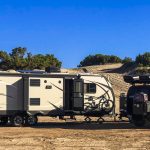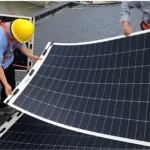For those seeking solitude and immersive adventure, dry camping allows enthusiasts to escape the confines of a traditional campsite and fully embrace nature. But what exactly is dry camping? How does it differ from other camping options?
Read on to learn the ins and outs of this adventure. We recommend using Sungold solar panels as a back-up power source for dry camping, especially the HP 400W Camping Solar Panel, which has the capacity to power 99% of outdoor appliances.
What is dry camping?
Dry camping is sometimes referred to as boondocking. it is similar to tent camping in that it is a more remote experience. But dry camping definitely involves the use of a caravan, trailer, tent camper or van.
Dry camping is essentially camping in an RV or trailer without any hookups. This means no electricity, water or sewer connections. Likewise, most dry camping situations do not include public Wi-Fi. It’s just you and your gear on a piece of land that may be located in the middle of nowhere.
What is the difference between wilderness camping and dry camping?
Wilderness camping and dry camping aren’t interchangeable terms, but there isn’t much difference between them. Technically, dry camping is an umbrella term to which wilderness camping falls under. Here are the differences between these two types of camping:
Dry camping: a broad term that covers any camping without amenities, whether the camping takes place in a designated campsite area with no connecting facilities or in a more natural and remote location. But dry camping doesn’t have to take place in the wilderness. It can also take place in car parks, friends’ driveways, recreational areas and other creative spaces.
Wild camping: Wild camping is camping in undeveloped wilderness areas. The further away from campgrounds and city life, the better. Wilderness camping is enjoyed by adventurous people who want to escape civilisation and find true solitude on public land.
There are obvious similarities between the two, as both follow the principle of self-sufficiency and rely on few outside facilities or amenities. However, wilderness camping is a more remote and extreme experience, with access to the most remote, pristine and unregulated environments.
Pros and Cons of Dry Camping
Pros of Dry Camping
So, what are the pros and cons of dry camping? First of all, the biggest advantage of dry camping is the low cost – or more accurately, the lack of cost. Many opportunities to dry camp on public land don’t cost a dime.
In some cases, dry camping on private land may be free, or in other cases there may be a small fee. In any case, dry camping does not include renting expensive campsites on public campgrounds.
Other advantages include:
- Fewer landowner restrictions
- More options for parking locations
- Fewer campers (if any)
- More access to nature.
- Disadvantages of Dry Camping
As far as cons go, the biggest one is living off the grid. No connection means you have to carry all your water with you. This means being careful not to fill up your waste water tank. It also means carrying extra gas or cooking over a fire.
Disadvantages of dry camping
- Legal restrictions (certain lands are off limits)
- Occasional permits are required
- Must carry everything you need
- Limited facilities
- Greater work requirements
What you need to prepare for dry camping?
There’s nothing more comfortable than camping in the wilderness, where you can get closer to nature and forget all your worries.
Motorhomes can enhance your camping experience by allowing you to take the essentials of home with you when travelling in the wilderness, such as a comfortable bed. Dry camping is a great way to escape the crowds at RV campgrounds and experience nature. While dry camping may seem daunting to the uninitiated, with the right preparation and mindset, anything is possible.
- Extra Fuel: If you plan on dry camping in the winter, you’ll need propane to stay warm.
- Water filters and bladders: fill your fresh water tank when you stop.
- Outdoor grills: grills or outdoor cookers make it straightforward to cook and carry dried camp food.
- Camping chairs and table: you can use this chair and table to relax outside your RV.
- Outdoor Lights: dimmable LEDs won’t drain your batteries and can be mounted.
- Emergency kit: a necessity when dry camping.
Power supply is one of the biggest challenges of dry camping. You can easily connect to shore power when parked at a campsite, but when camping in the wilderness, you have to carry power. So bring extra. Make sure your caravan battery ends up fully charged and carry powerful solar panels.
As a leading solar brand, Sungold is committed to producing the highest quality solar products, including solar panels and portable power generation solutions.Sungold’s solar range includes the HP Series of solar panels, which are highly efficient at converting solar energy for later use.
When in operation, Sungold’s solar panels produce pure, clean energy without causing any harm to the environment.
7 Dry Camping Tips
Before you embark on your first dry camping trip, follow these tips to ensure safety, comfort and efficiency.
1. Arrive with a full fresh water tank
Make sure your fresh water tank is full before you leave so you don’t run out of water. Bring more water than you need; you may have to travel long distances to get fresh water.
2. Be prepared to store your rubbish
One thing campers forget when dry camping is that there are no bins readily available like there are at campgrounds. Bring rubbish bags with you and plan to pack all your rubbish as there are no rubbish disposal facilities here.
The less waste you can use, the less you need to store, so choose beeswax wraps over plastic bags or aluminium foil, reusable cutlery over plastic forks and knives, spray cleaners and microfibre towels over cleaning wipes.
3. Provide multiple power options
Rely on multiple power sources such as solar panels, generators and portable power stations for versatility. Solar panels are one of the most reliable options because as long as there’s sunlight, you’ll always have electricity. But perhaps consider bringing some propane and a power source that can be powered by propane in case you get stranded on a cloudy day.
4. Prepare meals or use disposable plates
Plan meals that require minimal cooking and clean-up to save resources. If you can prepare them before you leave for your adventure, even better.
Prepare a few sandwiches, muffins, quiches, etc. to minimise utensils and kitchen needs. Then, consider using disposable plates or just one reusable plate to save as much water as possible for dishwashing.
5. Share your plans and location with loved ones
For safety reasons, be sure to inform others of your itinerary and location. When camping in remote areas, it is vital to let others know where you will be in case of an emergency. If you know your campsite has a cellular network, keep your phone charged so your loved ones can reach you if necessary.
6. Know your local laws
Research local regulations and dry camping guidelines to ensure compliance with legal requirements. There are some grey areas in dry camping, such as setting up a campsite in a car park or on a city street, so doing some research can save you from fines, tickets and further legal hassle.
7. Putting out the campfire
Whenever you go dry camping, it’s important to follow outdoor fire safety rules. Use water to extinguish the fire, and make sure you take this into account when preparing water for your trip. Never let a fire burn to keep wildlife and plants safe.
What size solar panel do I need for dry camping?
Carrying a solar panel while camping is essential as it can power your appliances and allow you to communicate with others in case of an emergency.The Sungold HP Series 400W solar panels for camping are known for their resilience, portability and power. When it comes to solar energy, you must determine the size of the solar system required.
First, determine the electrical requirements of each appliance and then match them to the right size solar generator. Here’s the formula for calculating how long it will take the Sungold HP Series 400W solar panels to charge your dry camping equipment:
Calculation formula
Operating Time = Solar Generator Capacity × 0.85 / Operating Wattage of Appliance
Example Calculation
If you use a Sungold HP Series 400W solar panel (assuming it has a capacity of 3024Wh) to charge your light (5 watts), the time it will run is calculated as follows:
Operating time = 3024Wh × 0.85 / 5W
Operating time = 2570.4 / 5
Operating time ≈ 514.08 hours
This means that the Sungold HP Series 400W solar panel will power a 5W light for approximately 514 hours.
Determining the electrical requirements of the appliance
In order to accurately calculate the size of solar generator you need, you should:
Make a list of all the devices that need to be powered.Record the power (wattage) of each device.Estimate the number of hours per day that each device will be used.
Example devices and wattage
- LED light: 5W
- Smartphone charging: 10W
- Laptop: 50W
- Small refrigerator: 60W
Daily Power Consumption Calculation
Assume that each device is used for the following number of hours per day:
LED light: 5W × 4 hours = 20Wh
Smartphone charging: 10W × 2 hours = 20Wh
Laptop: 50W × 3 hours = 150Wh
Small refrigerator: 60W × 24 hours = 1440Wh
Total power consumption = 20Wh + 20Wh + 150Wh + 1440Wh = 1630Wh
Based on the total power consumption, select the solar generator capacity that meets your needs. The Sungold HP series 400W solar panels, for example, will provide enough power to meet the needs of most camping equipment.
Dry Camping Frequently Asked Questions
The following are frequently asked questions about dry camping:
1. Is dry camping safe?
Dry camping is very safe if you know your requirements and surroundings.
2. Where can I dry camp?
There are many locations suitable for dry camping. You can dry camp at state or national park campgrounds or commercial campgrounds without hookups.
Thousands of acres of public lands allow dry camping, primarily national forests, Bureau of Land Management lands, and Army Corps of Engineers lands. The U.S. Forest Service publishes maps indicating where backcountry and camping is allowed, but national parks rarely allow dry campers to access remote areas.
RVs are allowed at multiple truck stops, highway rest areas, and large shopping malls, but overnight stays are prohibited where indicated. Private land is an option for dry camping when permitted by the property owner.
Final Thoughts
Obviously, dry camping is not for everyone. In fact, some people invest in motorhomes, fifth-wheel trailers and travel trailers because they want the comforts of home in their camping experience. For them, dry camping may not be the ideal use for an expensive RV. But for others, dry camping is definitely worth trying once in a while.








